Potřebujeme váš souhlas k využití jednotlivých dat, aby se vám mimo jiné mohly ukazovat informace týkající se vašich zájmů. Souhlas udělíte kliknutím na tlačítko „OK“.
ASTM F2149-01(2007)
Standard Test Method for Automated Analyses of Cells-the Electrical Sensing Zone Method of Enumerating and Sizing Single Cell Suspensions
Automaticky přeložený název:
Standardní zkušební metoda pro automatické analýzy buněk-Elektrotechnika detekční oblast metoda výčtu a dimenzování Single buněčných suspenzí
NORMA vydána dne 1.10.2007
Informace o normě:
Označení normy: ASTM F2149-01(2007)
Poznámka: NEPLATNÁ
Datum vydání normy: 1.10.2007
Kód zboží: NS-52995
Počet stran: 4
Přibližná hmotnost: 12 g (0.03 liber)
Země: Americká technická norma
Kategorie: Technické normy ASTM
Kategorie - podobné normy:
Anotace textu normy ASTM F2149-01(2007) :
Keywords:
automated cell counting, electrical sensing zone, size distribution, ICS Number Code 07.100.01 (Microbiology in general)
Doplňující informace
| Significance and Use |
|
This assay is used in university tissue culture laboratories, government research, and hospital, biomedical, and pharmaceutical laboratories to automate cell counting and sizing. This instrumentation provides very rapid, accurate, and precise results for any tissue culture facility. In addition, as noted, since the cell sizes to be analyzed by the instrument are set by the user, the analyses may be done on virtually any species of cells and cell type; it is not restricted to human cells or blood cells. The electrical sensing zone methodology was introduced in the mid 1950s (9). Since this time, there have been substantial improvements which have enhanced the operator’ease of use. Among these are the elimination of the mercury manometer, reduced size, greater automation, and availability of comprehensive statistical computer programs. This instrumentation offers a rapid result as contrasted to the manual counting of cells using the standard counting chamber, hemocytometer. The counting chamber is known to have an error of 10 to 30 %, as well as being very time consuming (10). In addition, when counting and sizing porcine hepatocytes, Stegemann et al concluded that the automated, electrical sensing zone method provided significantly greater accuracy, precision, and speed, for both counts and size, compared to the conventional microscopic or the cell mass-based method (7). |
| 1. Scope |
|
1.1 This test method, provided the limitations are understood, covers a procedure for both the enumeration and measurement of size distribution of most all cell types. The instrumentation allows for user-selectable cell size settings, hence, this test method is not restricted to specific cell types. The method is appropriate for suspension as well as adherent cell cultures (). This is a quantitative laboratory method not intended for on-line or field use. Results may be reported as number of cells per millilitre or total number of cells per volume of cell suspension analyzed. Both count and size distribution may be expressed in cell micron diameter or volume, femtolitres. 1.2 Cells commonly used in tissue-engineered medical products () routinely are analyzed. Examples are chondrocytes (), fibroblasts (), and keratinocytes (). Szabo et al used the method for both pancreatic islet number and volume measurements (). In addition, instrumentation using the electrical sensing zone technology was used for both count and size distribution analyses of porcine hepatocytes placed into hollow fiber cartridge extracorporeal liver assist systems. In this study (), and others (, ), the automated electrical sensing zone method was clearly validated for superior accuracy and precision when compared to the conventional manual method, visual cell counting under a microscope using a hemocytometer. This validation has been demonstrated over a wide variety of cell types. In addition, the automated procedure is rapid, rugged, and cost effective; it also minimizes operator-to-operator variability inherent in manual techniques. 1.3 This instrumentation is manufactured by a variety of companies; however, the principle used in all is electrical impedance. This test method, for cell counting and sizing, is based on the detection and measurement of changes in electrical resistance produced by a cell, suspended in a conductive liquid, traversing through a small aperture (see ()). When cells are suspended in a conductive liquid, phosphate-buffered saline for instance, they function as discrete insulators. When the cell suspension is drawn through a small cylindrical aperture, the passage of each cell changes the impedance of the electrical path between two submerged electrodes located on each side of the aperture. An electrical pulse, suitable for both counting and sizing, results from the passage of each cell through the aperture. The path through the aperture, in which the cell is detected, is known as the "electronic sensing zone." This test method permits the selective counting of cells within very narrow size distribution ranges by electronic selection of the generated pulses. While the number of pulses indicates cell count, the amplitude of the electrical pulse produced depends on the cell's volume. The baseline resistance between the electrodes is due to the resistance of the conductive liquid within the boundaries of the aperture. The presence of cells within the "electronic sensing zone" raises the resistance of the conductive pathway that depends on the volume of the cell. Analyses of the behavior of cells within the aperture demonstrates that the height of the pulse produced by the cell is the parameter that most nearly shows proportionality to the cell volume. 1.4 Limitations are discussed as follows: 1.4.1 CoincidenceOccasionally, more than a single cell transverses the aperture simultaneously. Only a single larger pulse, as opposed to two individual pulses, is generated. The result is a lower cell count and higher cell volume measurement. The frequency of coincidence is a statistically predictable function of cell concentration that is corrected by the instrument. This is called coincidence correction (). This phenomenon may be minimized, thus ensuring greater result accuracy, by using relatively low cell concentrations, around the 5 % level. 1.4.2 ViabilityAutomated cell counting enumerates both viable and nonviable cells. It does not measure percent cell viability. To measure the percent cell viability, either a vital dye or nonvital dye, such as trypan blue, procedure must be performed. 1.4.3 Size Variation of the Cell Sample Up to 30 to 1 by cell diameter in microns; 27 000 to 1 by cell volume. This is simply a function of the size range capability of the particular aperture size selected. Using this technology, measurements may be made in the range of about 0.6 to 1200 m. The lower size limit is restricted only by thermal and electronic noise. 1.4.4 Size Range of the ApertureThe size range for a single aperture is proportional to its diameter, D. The response has been found to depend linearly on D over a range from 0.02 D to 0.80 D; however, the aperture tube may become prone to blockage at levels greater than 0.60 D. The practical operating range, therefore, of the aperture is considered to be 2 to 60 % of the diameter. 1.4.5 Humidity10 to 85 %. 1.4.6 Temperature10 to 35C. 1.4.7 Electrolyte SolutionThe diluent for cell suspension must provide conductivity and have no effect on cell size. The electrolyte of choice is most often physiologic phosphate buffered saline. |
Podobné normy:
Historická
15.11.2011
Historická
1.12.2012
Historická
1.10.2013
Historická
1.4.2012
Historická
1.3.2010
Historická
1.4.2012
Doporučujeme:
Aktualizace technických norem
Chcete mít jistotu, že používáte pouze platné technické normy?
Nabízíme Vám řešení, které Vám zajistí měsíční přehled o aktuálnosti norem, které používáte.
Chcete vědět více informací? Podívejte se na tuto stránku.


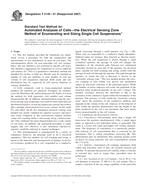
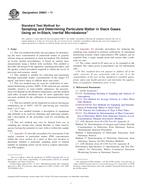 ASTM D6831-11
ASTM D6831-11 ASTM D7847-12
ASTM D7847-12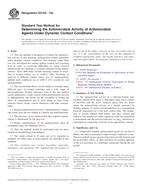 ASTM E2149-13a
ASTM E2149-13a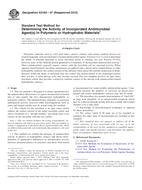 ASTM E2180-07(2012)..
ASTM E2180-07(2012).. ASTM E2186-02a(2010)..
ASTM E2186-02a(2010)..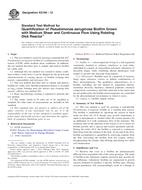 ASTM E2196-12
ASTM E2196-12
 Cookies
Cookies
